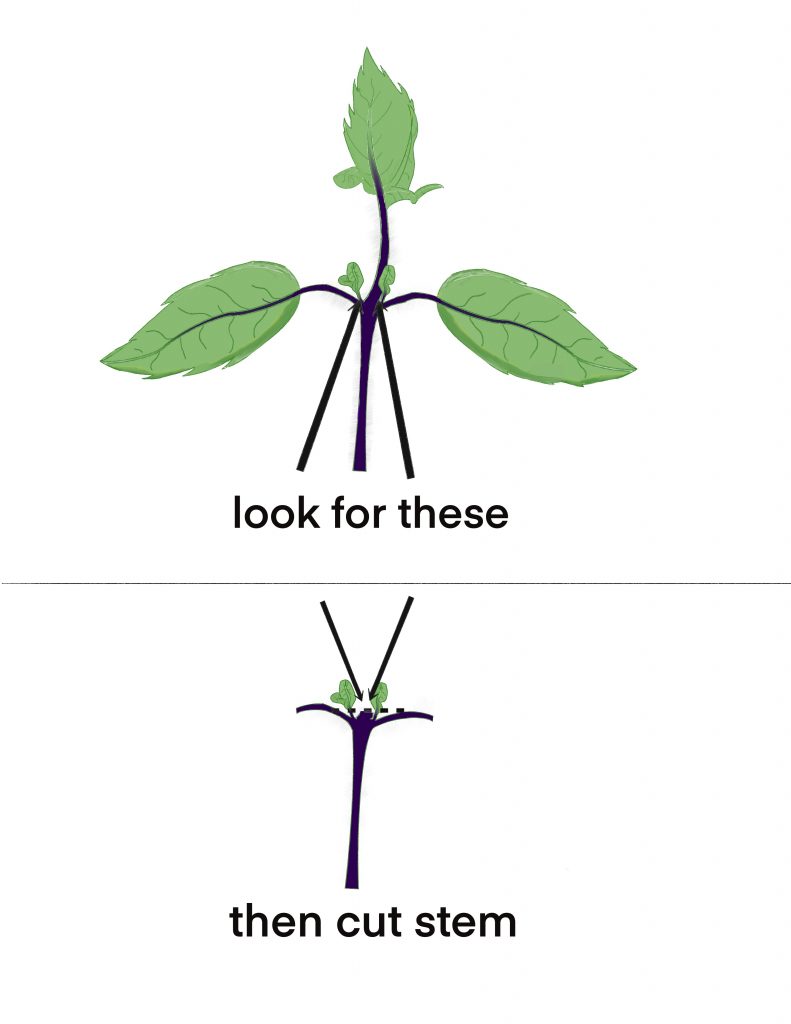There are several variations of Thai basil, including:
- Sweet Thai basil: popular herb throughout Southeast Asia
- Siam Queen Thai basil: tasty, improved version of Sweet Thai basil
- Thai lemon basil: a slight taste and scent of lemon
- Thai lime basil: a slight taste and strong scent of lime
- Holy basil: spicy, peppery, strong clove-like taste; commonly preferred in Thai and Indian dishes; a wide range of medicinal uses
Sweet Thai, Siam Queen Thai and Holy Basil are more suitable for cooking under high or extended cooking temperatures than that of sweet basil varieties, and lemon and lime basils. Thai basil releases more flavor when cooked; it also does not wilt and is ideal in Asian curries and soups.
Appearance
- stems are purple, leaves shiny, green or purple
- leaves edges are smooth
- small, sturdy, narrow leaves
- pink-purple flowers
- 12 – 18 inches tall
- prolific in hot, sunny locations
Taste
- strong anise-clove, licorice-like, sweet, and slightly spicy
- sweet aroma
- younger leaves (on top of the herb) are tastier than older leaves
- best consumed cooked
Benefits
- provides an excellent source of vitamin K, manganese, iron, vitamin A, vitamin C, calcium, zinc, magnesium, and omega-3 fatty acids
- treats migraines
- soothes muscle aches
- helps cuts and skin infections
- relieves itching from insect bites
- aids in digestion, upset stomach
- acts as anti-inflammatory
- combats colds, coughs, asthma, bronchitis
- fights free radical activity
- helps with depression, anxiety, nervous conditions
- manages diabetes
- supports the liver
- detoxifies the body
Planting
Basil plants are sensitive to frost, and prolonged exposure to temperatures below 50 degrees Fahrenheit can harm or kill the plant. Start seeds 6-8 weeks before the last frost in spring. For a head start, sow seeds a quarter of an inch deep in a small pot or jiffy peat pod, or use the paper towel method, and then transfer to a pot once seeds sprout in about 7-14 days.
Seeds may also be sown directly in soil when temperatures rise above 60 degrees F. Mix soil with compost and coffee grounds to prepare the garden planting area. Thai basil is more particular when it comes to soil and sun requirements; it needs a slightly low pH, rich organic matter, moist soil and sunny location. Cover seeds with 1/4 inch of loamy soil. Keep the soil moist; water lightly until seeds root and sprouts become more resistant to disturbance.
Location
Basil plants need a warm and sunny spot to thrive. Six to eight hours of direct sunlight is ideal. Basil does best when soil and air are warm. Be conservative about when to move plants outside in the spring; make sure the weather will be consistently warm. Basil will grow in partial shade, however its flavor will be more developed in full sun.
Caring for Basil
Basil copes with little water, however, does not like water logging and will not survive frost. Basil does best in moist soil, but when overwatered, the roots can rot and the plant can die. The first signs you may see above the soil are yellow and drooping leaves. Always put your finger about an inch into the soi to test for moisture; do not rely on eyeballing the top of the soil.
Thai basil needs compost amendment regularly. It also bolts quickly if flowers are not deadheaded regularly.
Growing Indoors
Sweet Thai Basil is an extremely easy option if you are planning to grow them in pots indoors. They can last up to 5 years if kept pruned regularly once it reaches a foot tall.
Harvesting
Prune plants to harvest leaves before the herb starts to flower. Harvest the leaves from the top down. Cut above each node (leaf pair) on a stem rather than leaving a stub. Leave 4″-6″ of the plant above the ground. Basil grows rapidly. After a major pruning, the herb will be ready for harvest again in a few weeks.

Prune with care since leaves bruise easily. Use soon after harvesting, or store cuttings in a jar of water to extend shelf life. Cuttings may even root and produce a new plant. If you want to encourage leaf-growth, and delay the death of your basil plant, you need to deadhead your basil often, especially when you see flowers.
End of the Season
Sweet thai basil can survive for up to five years in an area where temperatures never reach below 50 degrees F. If the weather does become too cold, the plant will die. If you expect a cold climate, you may want to allow your basil plants to bolt before temperatures drop so you can save seeds for the following season.


